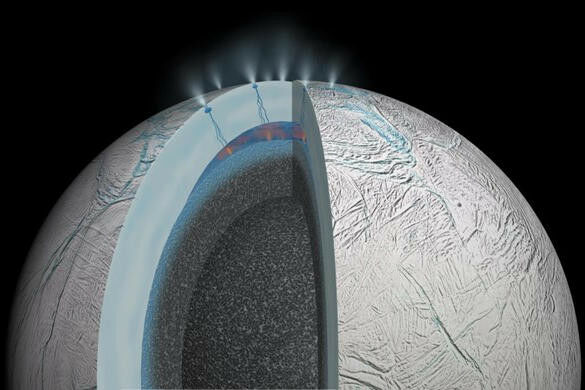Micro organism past Earth?

Indicators of year perceivable in unmarried ice grains emitted from moons orbiting Saturn and Jupiter
The ice-encrusted oceans of one of the most moons orbiting Saturn and Jupiter are top applicants within the seek for extraterrestrial year. A untouched lab-based learn about led via Freie Universität Berlin and the College of Washington, Seattle, displays that specific ice grains ejected from those planetary our bodies might comprise enough quantity subject material for tools headed there this autumn to stumble on indicators of year – if such year exists. “For the first time we have shown that even a tiny fraction of cellular material could be identified by a mass spectrometer onboard a spacecraft,” says govern writer Dr. Fabian Klenner , a postdoctoral researcher on the Branch of Earth and Area Sciences, College of Washington. Klenner performed analysis at Freie Universität Berlin till 2023. “Our results give us more confidence that new, upcoming instruments will soon allow us to detect lifeforms similar to those on Earth, which we increasingly believe could be present on ocean-bearing moons.
The open-access study “The right way to Establish Cellular Subject material in a Unmarried Ice Grain Emitted from Enceladus or Europa” was published on March 22, 2024, in the scientific journal Science Advances ( ).
The Cassini mission that ended in 2017 discovered parallel cracks near the south pole of Saturn’s moon Enceladus. Emanating from these cracks is a plume containing gas and ice grains formed from the moon’s subsurface ocean. Scheduled to launch in October of this year, NASA’s Europa Clipper mission will explore Europa, one of Jupiter’s icy moons, in more detail than ever before.
To prepare for this mission, researchers are studying what the new generation of instruments on board Europa Clipper might find. The authors used an experimental setup at Freie Universität Berlin that sends a thin beam of liquid water into a vacuum, where it disintegrates into droplets. They then used a laser beam to excite the droplets and mass spectral analysis to mimic what a mass spectrometer on the space probe will detect.
Newly published results show that instruments slated to go on future missions, like the SUrface Dust Analyzer onboard Europa Clipper, are capable of detecting cellular material, even if this is present in only one out of hundreds of thousands of ice grains.
The study focused on Sphingopyxis alaskensis, a common bacterium in waters off Alaska. Compared to the bacterium Escherichia coli, which many studies use as a model organism, this single-celled organism is much smaller, lives in cold environments, and requires only a few nutrients to survive. These characteristics make it a more suitable candidate for potential life on the icy moons of Saturn or Jupiter.
“Those micro organism are extraordinarily tiny, which means that, in concept, they may well be contained inside ice grains emitted from an ocean global like Enceladus or Europa,” says Klenner.
Earlier studies have shown that different compounds from a subsurface ocean separate into individual ice grains when expelled into space. The new research shows that analyzing single ice grains, in which biomaterial may be concentrated, would be a more successful method of identifying life than the practice of averaging across a larger sample containing billions of individual grains.
A recent study led by the same researchers showed evidence of phosphate on Enceladus. This planetary body now appears to contain energy, water, phosphate, and other salts and carbon-based organic material, making it increasingly likely to support lifeforms similar to those found on Earth.
The authors hypothesize that if bacterial cells are encased in a lipid membrane, as found on Earth, then they would also form a skin on the ocean’s surface. On Earth, ocean scum is a key part of sea spray that contributes to the smell of the ocean. On an icy moon where the ocean is connected to the surface (e.g., through cracks in the ice crust), the vacuum of outer space would cause this subsurface ocean to boil. Gas bubbles rise through the ocean and burst at the surface, where cellular material could get incorporated into ice grains within the plume.
“We right here describe a believable state of affairs for a way bacterial cells can, in concept, be integrated into cold subject material this is shaped from liquid H2O on Enceladus or Europa and next will get emitted into length,” says Klenner.
The analytical capabilities of the SUrface Dust Analyzer onboard Europa Clipper will be even greater than those of instruments on past missions. For the first time, this and other instruments on board future missions will be able to detect ions with negative charges from ice grain impacts, making them better equipped to detect fatty acids and lipids.
“For me, it’s much more thrilling to search for lipids, or for fatty acids, than to search for the construction blocks of DNA. It is because fatty acids seem to be extra strong,” says Klenner.
“With appropriate tools, such because the SUrface Mud Analyzer on board NASA’s Europa Clipper length probe, it could be more straightforward than we idea to search out year, or strains of it, on cold moons – this is, in fact, if year is provide there and cares to be enclosed in ice grains originating from an order reminiscent of a subsurface H2O reservoir,” says senior co-author Educator Frank Postberg , schoolmaster of planetary sciences on the Institute of Geological Sciences at Freie Universität Berlin. The alternative co-authors are Janine Bönigk, Dr. Maryse Napoleoni, Dr. Jon Hillier, and Dr. Nozair Khawaja (Freie Universität Berlin); Educator Karen Olsson-Francis (The Discoverable College, UK); Dr. Morgan Cable and Dr. Michael Malaska (NASA Jet Propulsion Laboratory, USA); Educator Sascha Kempf (College of Colorado Boulder, USA); and Educator Bernd Abel (Leipzig College, Germany).
The Latin phrases veritas, justitia, and libertas, which body the seal of Freie Universität Berlin, rise for the values that experience outlined the instructional ethos of Freie Universität since its creation in December 1948.




